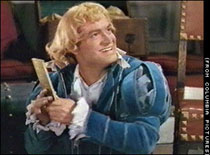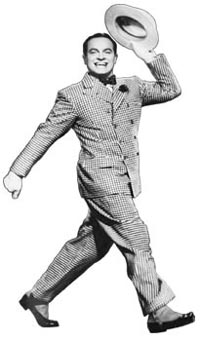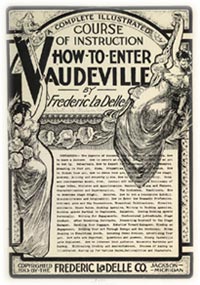| (insert your NIE or newspaper logo here) |
Weekly Online LessonOnline Lesson ArchiveGrade Level: 6-12
|
That's Comedy!
 Over
the last week, many celebrated the life of comic actor Bob Hope, who
marked his100th birthday on May 29, 2003.
Over
the last week, many celebrated the life of comic actor Bob Hope, who
marked his100th birthday on May 29, 2003.
Hope has been an American icon of comedy for many years. Beginning with his early days on the vaudeville stages in the 1920s, he's displayed his flair for funny in a variety of ways and through a variety of mediums — from live performances to radio, film and television.
As a unique and talented comedian, Hope has contributed much to the entertainment industry and to American culture in general. He also symbolizes the development of comedy in America over the last century.
So for this week's lesson, you'll discover how this man has delivered his style and humor to audiences all over the world. Plus, you'll get a look at American comedy's roots, and check out a gallery of America's funniest movies and television shows.
A Hundred Years of American Variety
 Although there have been many great comedians over the years, Bob Hope
is distinguished by his amazing charisma, wit and talent, as well as
the longevity of his career.
Although there have been many great comedians over the years, Bob Hope
is distinguished by his amazing charisma, wit and talent, as well as
the longevity of his career.
To learn more about Hope's life and the variety entertainment scene, explore the Library of Congress site, Bob Hope and American Variety. Begin by reading about his Early Life, Vaudeville and The Bill.
In what ways did Hope develop his talents as an entertainer? How did vaudeville reflect American culture at the time?
Find out how Hope's career evolved over the years by reading through Moving On, Bits & Sketches, Moving Pictures, Radio and Television.
For what reasons did vaudeville lose its popularity? What "stock materials" of vaudeville carried over into new media? How did these changes influence Hope's career, as well as the careers of other former vaudevillians?
Also read about Hope's Joke File, his On the Road: USO Shows, Public Service accolades and The Faces of Bob.
How has Bob Hope — his talent, charisma, caring and dedication — affected the lives of American citizens, from public audiences to military personnel to other comedians? In what ways have his image and humor influenced various aspects of the arts and other areas of American culture?
Comedy at Its Best, From Vaudeville to Film
 As
you've discovered, Bob Hope has led a successful life as a leading comedian.
But he was also just one among many talented performers in the early
years of modern American entertainment, which began at the turn of the
20th century.
As
you've discovered, Bob Hope has led a successful life as a leading comedian.
But he was also just one among many talented performers in the early
years of modern American entertainment, which began at the turn of the
20th century.
To get a glimpse at some of the other main characters who lit up vaudeville stages, visit the American Masters: Vaudeville site.
After reading the Feature Essay there, browse the Career Timeline, using your cursor to click-and-drag through it, from 1890 to 1934.
Now check out the biographies of four vaudevillians: Buster Keaton, Will Rogers, Stella Adler and Martha Graham. How did each artist contribute to the vaudeville experience? In what ways did their careers change after vaudeville's heyday?
Also, read about a few performers who were popular in other forms of media: Charlie Chaplin, Lucille Ball and Jack Parr. How did each actor use the medium to feature their comic talents and also keep audiences engaged with entertaining stories, interaction or dialogue? In what ways are these forms of comic entertainment different from or similar to live variety shows?
 Although live comedy theater is still around, most Americans get their
belly laughs watching movies and weekly shows on screen.
Although live comedy theater is still around, most Americans get their
belly laughs watching movies and weekly shows on screen.
So let's go to the movies and check out Comedy Films .What are the six different types? Do you prefer one type over another for any reason? Browse the American Film Institute's 100 Years...100 Laughs list of the top 100 comedies of all time. Which ones have you seen? Which ones made you laugh and why?
Now it's off to TV Land to tour the gallery of comic television shows, often called "situation comedies" or "sitcoms."
In the left-hand column of the Shows page, choose three or more shows to explore. Most pages offer briefs on the actors, characters, episodes, etc. You may want to check out All in the Family, Batman, (hit red phone to Launch Navigator), Chico and the Man, Gilligan's Island, The Honeymooners or The Munsters, for example.
How are each show's main characters and their routine situations different from those of another? What exactly made each show funny or likeable to the general viewing audiences — the characters, the actors, the costumes, props, scenes or script? How did these reflect the times during which they were originally broadcast? How do these and sitcoms today reflect American life and culture?
Newspaper Activities
In a current issue of Targetnewspaper, find articles about local comics who perform live, either solo as stand-ups or in a play with other actors. How does the newspaper describe the comedian's style or the play's flavor? (Alternatively, check the movie reviews for featured comedies.) If you were in the audience, do you think you'd laugh? Why or why not? Also check the newspaper's TV guide. How many funny sitcoms, movies or other shows — like variety talk shows — are listed? Compare the proportion to other types of shows, such as news, sports or drama.
© Copyright 2002
Learners Online, Inc.
